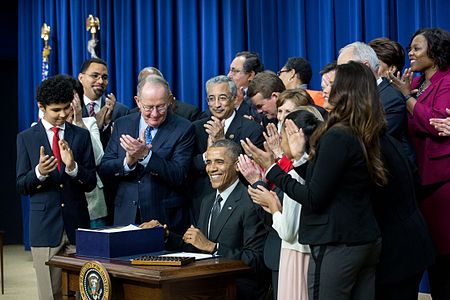Education policy at the state and local levels (2016)
 From Ballotpedia - Reading time: 10 min
From Ballotpedia - Reading time: 10 min
News coverage of national politicians and influencers debating the implementation of Common Core or education legislation such as the Every Student Succeeds Act (ESSA) suggests that these are the only important elements of modern American education policy. However, this news coverage often fails to acknowledge the significant and wide-ranging education policy at both the state and local level.
Although these state and local education policies may not be household names, examining them together reveals larger themes about American education. State budgets, teacher and student strikes, school board partisanship, recall efforts, and more are all being used to shape public schools from three main angles: funding, governance, and curriculum. K-12 education may fly beneath the national radar in 2016's federal elections, but the schools attended by tens of millions of American children will continue to be reshaped at the state and local levels—particularly through school board elections—in 2016.
Over the course of 2016, Ballotpedia put a spotlight on education policy looked at the trends and themes that connected them and the effects they had on school board elections. In 2016, 648 of America's largest school districts by enrollment held elections for 1,959 seats. These elections took place in 38 states across districts that collectively educated a total of 17,179,972 students during the 2013-2014 school year—34 percent of all K-12 students in the United States.[1] Click on the gray tabs below to learn more about these key areas of education policy at the state and local level.
Education policy arenas to watch in 2016[edit]
Funding[edit]
Funding formulas and education policy[edit]
- For the full story, see: State funding battles and local responses.
From school choice to teacher merit pay, funding is key to realizing any education policy effort. At the same time, exactly what states are trying to encourage or discourage through budget changes can be a tangle to unravel. School districts rely on revenues from federal, state, and local taxes to fund their operations, and local superintendents and board members frequently testify before their state legislatures to for advocate education policy and spending changes.
When a state adjusts its funding formula—the calculation that determines how much state funding each particular school district receives—there is an opportunity to set criteria that tie district funds to compliance with particular policies. Legislators cast the votes to set state budgets and funding formulas, but not without comment from local school district leaders. When funding from the state is tied to policy change movements, districts may have little choice but to participate, or they may have to increase local funding to compensate for shifts in funding.
No single effort to change educational funding policies operates in isolation. Efforts aimed at raising teacher pay can simultaneously seek changes to tenure policies, merit pay, student-teacher ratio changes, and more. Ballotpedia tracked education funding policies across the United States throughout 2016, particularly as they connected to school board elections in the nation's largest districts.
Governance[edit]
Power and control of the education system[edit]
- For the full story, see: Battles over school governance
When problems add up in a school district, the most common way officials pursue change is to go after the issues. Sometimes, however, the problems are persistent enough that the district's governance structure gets a second look. The battles over school district governance can happen at the ballot box through regularly scheduled school board elections, in school board meetings through citizen-initiated petitions and referendums, or in state capitols through mandated takeovers. These battles seek to change the way a district is governed, and by doing so, improve the education of its students. Below is a description of the different types of school district governance structures and an overview of the governance battles being fought across the states in 2016.
American school districts are most commonly governed by multiple-member boards that oversee school district policies, finances, superintendents, and collective bargaining agreements with teachers and other staff. Districts differ in the way that school board membership is attained. Board members can be elected, appointed, or a combination of both. School board elections can be partisan or nonpartisan and can occur at any time of the year, depending on the locale.[2]
In some instances, elected school boards are disbanded and district superintendents are removed. Elections are subsequently suspended, and the boards and superintendents are appointed by an outside actor such as a state governor, a city mayor, or a state board of education commissioner. In Baltimore, for example, the city's school board is jointly appointed by both the governor of Maryland and the mayor of Baltimore. The reasons for removing or reducing local control can vary. A school district in fiscal distress or one with poor academic performance may face board dissolution. At times this action is taken due to possible illegal actions perpetrated by board members or the superintendent. Appointed boards have varying degrees of power and sometimes only serve as district advisors.
Governance battles can also be fought over specific policies. Regardless of how a school district is governed, sometimes a specific issue gets enough attention that citizens, superintendents, school boards, municipal governments, or the state struggle over who controls the outcome. The battle over policies surrounding Common Core was an example of this type of struggle. Other battles are fought over evaluating teachers, handling public information requests, and improving failing schools.
The variety in possible governance and election approaches for school boards matters because each results in a different emphasis and power structure, and there is no broad consensus as to what should be emphasized or how exactly power should be divided in education governance. There are practicalities about election costs and other issues when legislation moves school board election dates, changes a board from partisan to nonpartisan (or vice versa), makes an appointed board into an elected one, or provides for the creation of new school districts out of mergers of existing schools. Regardless of the practical motivations expressed, these changes also represent distinct shifts in the relationship between school district voters and those who govern their districts as well as in the power and role of political parties in the education system.
Curriculum[edit]
Standardized tests, history, sex, and religion[edit]
- For the full story, see: The fight to shape public school curriculum
Education policy is an important issue during presidential and Congressional election years. Even during non-election years, however, federal officials have historically taken stances on matters such as No Child Left Behind, Common Core, and the Every Student Succeeds Act. At the local level, more attention is given to the role of parents in schools and disputes over curriculum and testing than is given to these federal programs.
In recent decades standardized testing opt-outs, sex education curriculum, and book banning campaigns have been cornerstones of debates over how much power parents should have over modern public education. One such debate about the role of history education contributed to the replacement of an entire school board in Colorado following a recall effort proving that local voters are ready and willing to go to significant lengths to address concerns about curriculum. Arguments over curriculum reveal that education policy at the local level is not only significant in shaping the practice of education, but also in questioning and envisioning the fundamental purpose of education at a philosophical level. School boards and school board elections can significantly impact what, and how, children are taught in public schools.
Background[edit]
In the decade leading up to 2016, the American media focused on the national and federal debates about policy changes such as the No Child Left Behind Act, Common Core State Standards Initiative, and Every Student Succeeds Act (ESSA). Beneath the national current, significant trends in education policy have gone unacknowledged due to their localized and fragmented natures.
Right: President Barack Obama (D) signs the Every Student Succeeds Act into law on December 10, 2015. | |
Education Week described K-12 education as "an underdog topic in the 2016 presidential campaign" in early 2016 and noted the lack of a coordinated campaign to make it a focal point of the election cycle. The reporter noted that the role of the federal government "is expected to scale back" due to the passage of ESSA. Beyond the policy changes, however, Education Week highlighted the following:
| “ | Also, unlike eight years ago, there's no 'ED in '08' in the works. That campaign was an 18-month, $25 million effort financed jointly by the Bill & Melinda Gates Foundation and the Eli and Edythe Broad Foundation and designed to make education issues front and center during the 2008 presidential campaign. The ED in '08 effort didn't lead to a huge wave of K-12 policy discussion that year, but may have had an impact on subsequent school advocacy.[3] | ” |
| —"K-12 Still Struggling for Traction as Campaign Issue," Education Week (January 12, 2016)[4] | ||
Although education may be removed from the mainstream policy debates for federal offices, efforts to reform education carried on at the state and local levels. The "loosely coupled" structure of education governance, as described by Stanford University education professor David F. Labaree, may make smaller, localized reform efforts more likely to have a tangible impact on the classroom experience of American students. Whereas national reform efforts must work through several layers of bureaucracy before ever reaching the teacher in the classroom, a local activist school board candidate or recall campaign can swiftly change a district's governance from one year to the next.[5]
See also[edit]
Footnotes[edit]
- ↑ National Center for Education Statistics, "Elementary/Secondary Information System," accessed February 26, 2016
- ↑ National School Boards Association, "Frequently Asked Questions," accessed April 12, 2016
- ↑ Note: This text is quoted verbatim from the original source. Any inconsistencies are attributable to the original source.
- ↑ Education Week, "K-12 Still Struggling for Traction as Campaign Issue," January 12, 2016
- ↑ Labaree, D.F. (2012). Someone has to Fail. Cambridge, MA: Harvard University Press. (pages 130-131)
| |||||||||||
| |||||||||||||||||
]
 KSF
KSF



